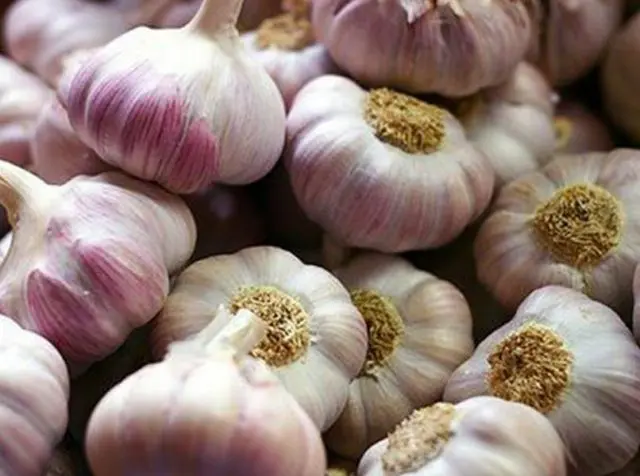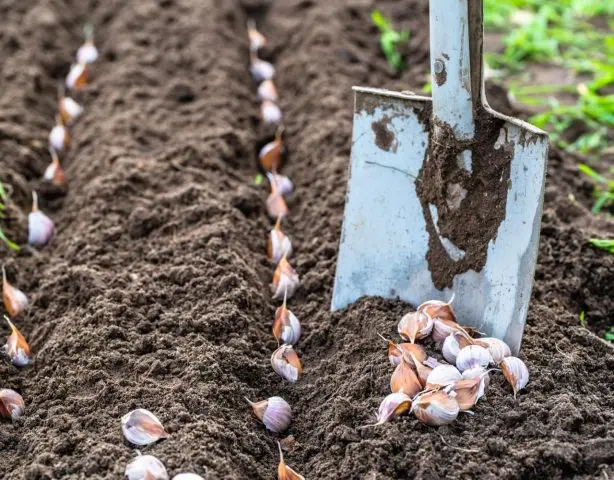Contents
The variety of garlic Azure is an arrowy winter type of crop, zoned in a temperate climate. Designed for personal and commercial cultivation. The variety is productive, mid-season, does not lose its presentation during long-term storage.
History of breeding
The variety of winter garlic Azure was created on the basis of CJSC CPT “Ovoshchevod” in Yekaterinburg. The originator is Candidate of Agricultural Sciences V.G. Susan. The basis was formed by local types of culture with good frost resistance. The main direction of hybridization is the creation of a new type of arrow garlic with a leveled, dense bulb, with a long shelf life, high yield and drought resistance. Variety Lazurny is zoned in the conditions of the Ural climate, showed good results and fully complies with the declared characteristics. In 2010, it was included in the State Register with a recommendation for cultivation in the European, Central, North-Western part of Our Country.

Description of Garlic Azure
Winter garlic Azure refers to a mid-season variety. Ripens in 120 days from the moment the young shoots appear. Due to the formation of an arrow, the head does not crumble after harvesting, maintaining integrity for the entire storage period. Garlic is grown in the farmer’s fields and in the garden. The culture is frost-resistant, tolerates high temperatures well with minimal watering, and is undemanding in agricultural technology.
A variety was created for cultivation in the temperate climate of the European part of the Federation, zoned in the Urals. The variety of garlic Azure has recently appeared on the seed market. Garlic is grown in Siberia in the Urals, Central Our Country, due to drought resistance it is suitable for cultivation in the southern regions.
Description of garlic Azure (pictured):
- The leaves are narrow, lanceolate, elongated, grooved, pointed upwards, length – 60 cm, width – 1,8-2 cm. The surface is smooth with a light waxy coating, the edges are even. The leaves are erect, the next leaf is formed inside the previous one, forming a false stem.
- The peduncle (arrow) is 65 cm high, an inflorescence in the form of a ball is formed at the top, covered with a film coating before flowering. The color of the arrow is one tone with the leaves.
- Inflorescence in the form of a spherical umbrella with sterile purple flowers, about 3 mm in diameter. It consists of small bulbs that are used to propagate the variety; the plant does not produce seeds.
- The bulb is formed in the axils of the scales, consists of 6 teeth of a simple structure. The shape of the bulb is round, slightly flattened near the root system, ribbed. Weight – 60 g.
- The bulb is covered with dry white scales with anthocyanin (purple) longitudinal stripes. The shell of the teeth is dense, leathery, light brown.
- The teeth are white with a mild pungent taste and a pronounced smell.
Is Azure garlic suitable for the Ural region
The culture was hybridized at the Ural Seed Institute. It was created specifically for growing in the conditions of Siberia and the Urals. It has been tested in this climate zone. It is also zoned in the Urals. The basis was local varieties of garlic with high immunity, drought resistance. The variety belongs to the winter, planted in the fall. Planting material winters safely, in the spring it gives friendly shoots. The frost resistance of Azure garlic is high, sprouts appear after the establishment of a positive temperature. Young shoots are not afraid of return frosts. According to all the characteristics and reviews, Lazurny winter garlic is ideal for growing in the Ural weather conditions.
Characteristics of garlic Azure
Winter garlic Azure is versatile in use. Due to its chemical composition, it is widely used in folk medicine. In cooking, it is used as a spicy seasoning for the first and second courses. It has an antibacterial property, it is used for salting, canning vegetables, consumed fresh. Garlic contains many vitamins necessary for the body in the winter season, so the long shelf life of Azure garlic is a priority when choosing a variety.
Productivity
The mid-late variety fully matures in the short summer of the temperate zone. Winter garlic gives the first shoots in the middle or at the end of May, the timing depends on how early or late the spring is. After two months, garlic reaches biological ripeness, harvesting is carried out in mid-July or early August. Variety Azure is suitable for use in the stage of conditional ripeness, “young” garlic is dug 1 month after germination.
The crop yield depends on the planting site and subsequent agricultural technology. The optimal site for garlic is a bed after harvesting potatoes, the site is quite fertile, while the crop rotation rule is not violated. The culture is drought-resistant, it has enough seasonal rainfall, in rare cases it is watered additionally.
On waterlogged soils, the plant will not produce a crop. The bed is placed in an open area. In the shade, the garlic stretches, the bulbs grow small in size with fine teeth. Another condition for high yields is the composition of the soil. On acidic clay soils, the culture grows poorly.
Under all conditions, garlic gives an onion up to 60 g in weight. 1 m2 planted, about 12 plants. The yield is 0,7-0,8 kg. This is an indicator for the climate of the European part. In the South, the productivity of the Lazurny variety from 1 m2 -1,2-1,5 kg.

Stability
The variety of garlic Azure is not afraid of a sharp drop in temperature at night, it tolerates dry hot summers well. Immunity to infections and pests in the culture is high. It resists fusariosis well, a manifestation of a bacterial disease is possible. Of the pests, there is a root mite and a stem nematode.
Advantages and disadvantages
The advantages of garlic varieties Azure include:
- large size of bulbs and teeth;
- resistance to diseases;
- good yield;
- long shelf life;
- the possibility of growing on private and farm plots;
- frost resistance;
- versatility in use.
The disadvantage of the variety is one – it poorly resists a number of pests.

Planting and care
To get a good harvest, you need to correctly determine when to plant Azure garlic and what agricultural technology is required. Planting work is carried out 45 days before the onset of frost, approximately in mid-October. The main indicator is the temperature of the soil, it should not be higher than +10 0C, this is enough for the rooting of the teeth and not enough for the formation of sprouts. The site is prepared in September: they dig it up, add organics, superphosphate, and add dolomite flour if the composition is acidic.
Planting garlic varieties Azure:
- Pour a bed 25 cm high, 1 m wide.
- Longitudinal furrows are made so that there is a layer (5 cm) of soil above the planting material.
- The teeth are placed at a distance of 15 cm from each other with the bottom down.
- Row spacing – 35 cm.
At 1 m2 an average of 10-12 seeds is obtained.
Garlic care:
- After germination, the earth is loosened, weeds are removed from the garden.
- When the plant grows up to 15 cm, the area is mulched with straw or dry leaves.
- At the beginning of the growing season, watering is not needed for the culture, enough moisture has accumulated over the winter. Water when the top layer dries out. In summer, in the absence of precipitation, watering is carried out once a week.
- The plant is treated with copper sulphate for prevention.
The main condition for obtaining large bulbs is timely top dressing. Nitrogen, superphosphate and mineral fertilizers are introduced. The aisle is sprinkled with ash. You can fertilize the bed with a solution of bird droppings.
Diseases and pests
The bacterial disease of garlic affects only winter varieties of the crop. Dark spots appear on the planting material, the teeth are poorly rooted. Shoots are rare in spring, yellowing of the upper part of the leaves is observed. You can avoid infection in the following ways:
- Timely drying of garlic in the sun after harvest.
- Selection of seeds only well ripened, without damage, large.
- Disinfection of teeth before planting with copper sulphate.
- Treatment with Energen.
- Top dressing during the growing season “Agricola-2”.
Compliance with crop rotation will exclude the development of infection.
The stem nematode often parasitizes on winter garlic of the Lazurny variety. The larvae feed on the juice of the bulb, the teeth stop growing and become soft. If pests are found, the affected plant is completely removed from the site. On this bed, planting garlic for 4 years is not considered. To prevent the development of a nematode, planting material is immersed in a 5% saline solution, it must be heated to +45 0C. Calendula is planted between the rows of garlic.
The root mite on the Azure variety is less common than the nematode. It affects the bulbs during storage, the teeth rot and disappear. Falls into the bulb in the spring from the soil. Control measures:
- sorting of planting material;
- if at least one infected bulb was found in the batch, all teeth are treated with a solution of colloidal sulfur per 10 l – 80 g before planting;
- the landing site is also treated with colloidal sulfur.
Root mite larvae overwinter in the soil. A bed for planting a crop is not used for 2 years.
Conclusion
Variety of garlic Azure – winter, arrowing type of culture. Zoned in a temperate climate. Suitable for cultivation on an industrial scale and in the garden. The plant is frost-resistant, the vegetation does not affect the lack of moisture. Gives stable, high yields. Bulbs are versatile in use.









